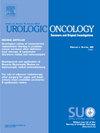先前治疗过的上尿路上皮癌后的高风险非肌肉浸润性膀胱癌的卡介苗反应和肿瘤预后:倾向匹配分析
IF 2.4
3区 医学
Q3 ONCOLOGY
Urologic Oncology-seminars and Original Investigations
Pub Date : 2025-04-22
DOI:10.1016/j.urolonc.2025.03.026
引用次数: 0
摘要
导读:原发性上尿路上皮癌(UTUC)治疗后膀胱异时性复发可发生在约3%至50%的患者中。由于UTUC表现出明显的分子改变,与原发性膀胱癌相比,这些患者的膀胱复发可能在分子和表型上有所不同。我们的目的是研究卡介苗在原发性高风险非肌性浸润性膀胱癌(P-NMIBC)和既往肾输尿管切除术后膀胱异时性复发患者中的疗效。方法:我们回顾了一个经irb批准的前瞻性泌尿肿瘤学数据库,该数据库包含了2017年至2021年接受切除后卡介苗治疗的高级别NMIBC患者。分析临床病理参数、膀胱内治疗及肿瘤预后。通过倾向评分匹配(PSM)将P-NMIBC组患者与M-NMIBC组(对照组)患者进行匹配,以调整潜在的临床病理混杂因素。最近邻居PSM的目标是研究对象与对照组的比例为4:1,使用0.2的卡尺,旨在获得结果的绝对标准化平均差异:在183名诊断为NMIBC的患者中,35名患者被确定为有根治性肾输尿管切除术的UTUC病史。EAU危险分层显示50例(27.3%)为中度危险组,107例(58.5%)为高危组,26例(14.2%)为极高危组。P-NMIBC患者更有可能出现症状表现(79.7% vs。23.9%),平均肿瘤大小(25.7 mm比15.4 mm)大于M-NMIBC。研究的平均随访时间为34.0个月。在非匹配分析中,与P-NMIBC相比,M-NMIBC与BCG后HG膀胱内复发的风险增加相关(54.3% vs。28.4%, P = 0.006,HR 2.14, 95% CI: 1.25-3.65),进展为MIBC的风险增加(28.6% vs. 1.65)。4.7%, p = 0.007,hr 4.19, 95% ci: 1.47 ~ 11.95)。对于倾向匹配分析,对照组由35名 M-NMIBC患者与123名P-NMIBC患者组成,具有相似的人口统计学,EAU风险评分和BCG剂量。M-NMIBC再次显示出更高的HG膀胱内复发率(54.3% vs。22.8%, P = 0.001,HR 2.67, 95% CI: 1.50-4.77),进展为MIBC(28.6% vs. 1.77)。5.7%, P = 0.022,HR 3.42, 95% CI: 1.20-9.75),进展到远处转移(20.0% vs. 0.9%)。6.5%, p = 0.033,hr 3.02, 95% ci: 1.09-8.35)。在非匹配和匹配分析中,两组的总生存率均无显著差异。结论:我们的研究表明,对于有UTUC病史的NMIBC患者,卡介苗治疗可能效果较差,且膀胱内复发和疾病进展的风险较高。在咨询患者卡介苗治疗和总体预后时,这是一个重要的考虑因素。本文章由计算机程序翻译,如有差异,请以英文原文为准。
BCG response and oncological outcomes in high risk nonmuscle invasive bladder cancer following previously treated upper tract urothelial carcinoma: A propensity-matched analysis
Introduction
Metachronous bladder recurrences after prior treatment for primary upper tract urothelial carcinoma (UTUC) can occur in ∼3% to 50% of patients. Because UTUC demonstrated distinct molecular alterations, bladder recurrences in these patients may be molecularly and phenotypically different compared to primary bladder carcinoma. We aim to study the BCG efficacy in patients with primary high risk nonmuscle invasive bladder cancer (P-NMIBC) and metachronous bladder recurrences after previous nephroureterectomy for UTUC (M-NMIBC).
Methods
We reviewed an IRB-approved prospective uro-oncology database of patients who underwent resection followed by BCG therapy for high grade NMIBC from 2017 to 2021. Clinicopathological parameters, intravesical therapies and the oncological outcomes were analyzed. Patients in the P-NMIBC group were matched to patients in the M-NMIBC cohort (control) via propensity score matching (PSM) to adjust for potential clinicopathological confounders. Nearest-neighbor PSM targeting a 4:1 ratio of study to control subjects was performed using a caliper of 0.2, aiming for an absolute standardized mean difference of <0.1 across key covariates. Secondary outcomes were progression to distant metastasis and overall survival. Logistic and cox regression analyses were performed to elucidate independent variables associated with intravesical recurrences and disease progression.
Results
Of the 183 patients diagnosed with NMIBC, 35 patients were identified to have a history of UTUC with radical nephroureterectomy. EAU risk stratification revealed 50 (27.3%) intermediate risk, 107 (58.5%) high risk and 26 (14.2%) very high risk groups. P-NMIBC patients were more likely to have symptomatic presentation (79.7% vs. 23.9%), and a larger mean tumor size (25.7 mm vs. 15.4 mm) than M-NMIBC. The mean follow-up duration for the study was 34.0 months. In the unmatched analysis, M-NMIBC was associated with increased risk of HG intravesical recurrence post BCG compared to P-NMIBC (54.3% vs. 28.4%, P = 0.006, HR 2.14, 95% CI: 1.25–3.65) and increased risk of progression to MIBC (28.6% vs. 4.7%, P = 0.007, HR 4.19, 95% CI: 1.47–11.95). For the propensity-matched analysis, the control group consisted of 35 M-NMIBC matched to 123 P-NMIBC patients for similar demographics, EAU risk score and BCG doses. M-NMIBC again demonstrated a higher HG intravesical recurrence rate (54.3% vs. 22.8%, P = 0.001, HR 2.67, 95% CI: 1.50–4.77), progression to MIBC (28.6% vs. 5.7%, P = 0.022, HR 3.42, 95% CI: 1.20–9.75) and progression to distant metastasis (20.0% vs. 6.5%, P = 0.033, HR 3.02, 95% CI: 1.09–8.35). Overall survival in both groups were not significantly different in both unmatched and matched analysis.
Conclusions
Our study indicates that BCG treatment may be less effective for NMIBC patients with a history of UTUC, with a higher risk of intravesical recurrences and disease progression. This is an important consideration when counselling patients for BCG treatment and overall prognostication.
求助全文
通过发布文献求助,成功后即可免费获取论文全文。
去求助
来源期刊
CiteScore
4.80
自引率
3.70%
发文量
297
审稿时长
7.6 weeks
期刊介绍:
Urologic Oncology: Seminars and Original Investigations is the official journal of the Society of Urologic Oncology. The journal publishes practical, timely, and relevant clinical and basic science research articles which address any aspect of urologic oncology. Each issue comprises original research, news and topics, survey articles providing short commentaries on other important articles in the urologic oncology literature, and reviews including an in-depth Seminar examining a specific clinical dilemma. The journal periodically publishes supplement issues devoted to areas of current interest to the urologic oncology community. Articles published are of interest to researchers and the clinicians involved in the practice of urologic oncology including urologists, oncologists, and radiologists.

 求助内容:
求助内容: 应助结果提醒方式:
应助结果提醒方式:


